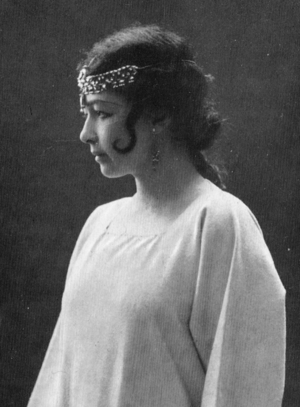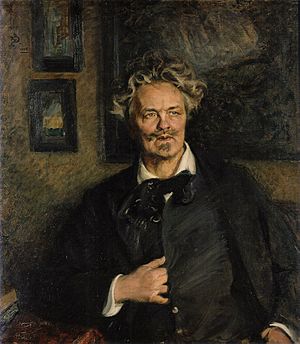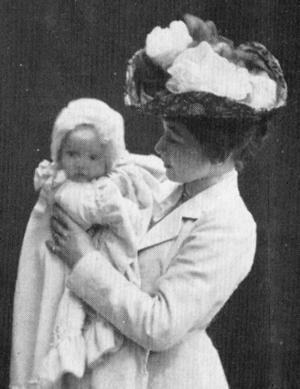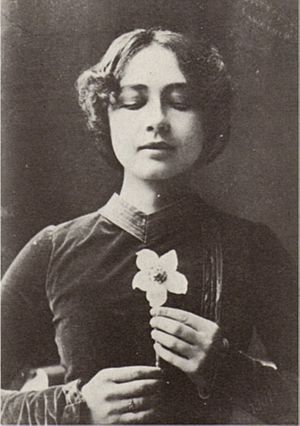Harriet Bosse facts for kids
Quick facts for kids
Harriet Bosse
|
|
|---|---|

Bosse as Indra's daughter at the 1907 première of A Dream Play (1902) by August Strindberg
|
|
| Born |
Harriet Sofie Bosse
19 February 1878 |
| Died | 2 November 1961 (aged 83) Oslo, Norway
|
| Occupation | Actress |
| Spouse(s) |
|
| Children | 2 |
| Relatives |
|
Harriet Sofie Bosse (born February 19, 1878 – died November 2, 1961) was a famous actress from Sweden and Norway. She was very well-known during her time. Today, many people remember her as the third wife of the famous writer August Strindberg.
Harriet started her acting career in a small theater group run by her older sister, Alma Fahlstrøm, in Kristiania (which is now Oslo, Norway). Later, she got a job at the Royal Dramatic Theatre in Stockholm, Sweden. There, her smart acting and unique look caught the eye of August Strindberg.
Harriet and Strindberg had a quick romance and got married in 1901. He was 52, and she was 23. Strindberg wrote many important roles for Harriet during their short and difficult marriage. This was a very creative time for him. Like his earlier marriages, this one ended because of Strindberg's strong jealousy. His feelings for Harriet, from deep love to anger, were often shown in the characters he wrote for her. Even though she was a big inspiration for Strindberg, Harriet always remained an independent artist.
Harriet Bosse later married Swedish actor Gunnar Wingård in 1908. She then married Swedish film actor and director Edvin Adolphson in 1927. All three of her marriages ended in divorce. She had a daughter with Strindberg and a son with Wingård. After a successful acting career in Stockholm, she moved back to Oslo, where she grew up.
Contents
Early Life and Career
Harriet Bosse was born in Kristiania, Norway (now Oslo). She was the thirteenth of fourteen children born to Anne-Marie and Johann Heinrich Bosse. Her father was a German publisher, and his work meant the family often moved between Kristiania and Stockholm, Sweden. Because of this, Harriet sometimes felt unsure if she was more Norwegian or Swedish. She traveled between the two cities many times, even making the long trip alone when she was just six years old. Harriet was a brave and independent child.
Two of Harriet's older sisters, Alma Fahlstrøm and Dagmar Möller, were already successful performers. Inspired by them, Harriet began acting in a Norwegian touring company. This company was run by her sister Alma and Alma's husband Johan Fahlstrøm. When she was eighteen, Harriet was asked to play Juliet in Romeo and Juliet. She wrote to her sister that she was very nervous before the first show. But then she loved performing, hearing the applause, and having people stare at her on the street the next day.
Alma was Harriet's first and only acting teacher, and she was quite strict. After a disagreement with Alma, Harriet left the company. She used a small inheritance from her father to study acting in Stockholm, Copenhagen, and Paris.
Harriet found the theater scene in Paris very inspiring. It was a time of new and old ways of putting on plays. She realized that her natural, realistic acting style was the right choice for her. When she returned to Scandinavia, she wasn't sure if she should work in Stockholm, which had more opportunities, or Kristiania, where she felt more at home. Even though she spoke Swedish with a Norwegian accent, her sister Dagmar, an opera singer, convinced her to try Stockholm.
Harriet applied to the Royal Dramatic Theatre ("Dramaten") in Stockholm. This theater was influenced by King Oscar II's traditional tastes. To get the job, Harriet had to work hard on her Swedish speaking skills. She became famous on the Swedish stage for her beautiful voice and clear way of speaking. She joined Dramaten in 1899, when August Strindberg's new play Gustaf Vasa was very popular.
Marriage to August Strindberg
About August Strindberg

Harriet Bosse was a successful actress on her own. However, she is mostly remembered as the third wife of the Swedish writer August Strindberg (1849–1912). Strindberg was a very important writer who helped shape modern plays. He became famous in the 1870s for his critical writings and his well-known book The Red Room (1879).
In the 1890s, he went through a very difficult time, which he called the "Inferno Crisis." After this, his writing changed from realistic stories to more symbolic ones. Around 1900, he was very creative and famous.
Strindberg had a reputation for disliking women, but all his wives said this wasn't true. Harriet wrote that during their marriage, she saw him as "a completely natural, kind, honorable, faithful man—a 'gentleman'." However, Strindberg's marriages were always troubled by his jealousy and extreme sensitivity.
Their Romance

Even before they met, Harriet was impressed by Strindberg's new and bold plays. She found him interesting because he challenged old ideas and had already been through two difficult marriages.
Strindberg was fascinated when he saw Harriet play Puck in A Midsummer Night's Dream. She often played playful or "exotic" characters. He immediately thought she would be perfect for the role of The Lady in his next play, To Damascus.
Strindberg tried to win Harriet over by sending her books about spiritual topics. He also tried to influence her thinking and help her career. He wrote plays with main roles he thought would be good for her and tried to get the theater to cast her. Harriet said she often felt she wasn't experienced enough for such big roles, and the theater management agreed. But Strindberg was powerful in the theater and often got his way.
The role of Eleonora in Easter (1901) became Harriet's most successful and favorite role. It was also a turning point in her relationship with Strindberg. They got engaged in March 1901, during the rehearsals for Easter.
Marriage and Divorce
Harriet Bosse and August Strindberg were married on May 6, 1901. Strindberg believed in living a simple life, focused on spiritual things. He didn't want anything in their home that would remind them of everyday life. Harriet wrote that Strindberg was protective and tried to guide her on his spiritual path. But she, at 22, felt she wasn't ready to leave this world behind.
Strindberg became more and more afraid of going outside. He tried to overcome this so his young wife could enjoy summer trips. He planned carriage rides, but often, he would change his mind at the last minute. For example, in June 1901, Strindberg planned a honeymoon trip to Germany and Switzerland but then canceled it. Harriet wrote that she had to stay home and cry while Strindberg tried to comfort her by giving her a travel guide "to read a trip in."
The canceled trip was the beginning of the end. A sad and defiant Harriet went alone to a beach resort in Denmark. It was a shorter trip, but she found it wonderfully refreshing. Strindberg soon followed her with letters and then came himself. He tried to handle the social life Harriet enjoyed. However, their relationship quickly fell apart due to his jealousy and suspicion.
When their daughter Anne-Marie was born on March 25, 1902, Harriet and Strindberg were already living apart. Harriet wrote to Strindberg, "For the sake of us both it is best that I do not return." She added that continuing to live with his suspicion "would be the end of me." At her request, Strindberg started the divorce process.
Strindberg's Roles for Bosse
Strindberg and Bosse's relationship was very dramatic. Strindberg would swing between loving Harriet as his creative inspiration and being wildly jealous. His letters show that Harriet inspired several important characters in his plays, especially in 1901. He would sometimes promise to help her get roles to influence her.
During this short, intense, and creative period in 1901, the roles Strindberg wrote for Harriet, or that were based on their relationship, showed both his love and his "suspicion of every word, every act." Eight minor and six major roles were written for Harriet to act or were inspired by her. Many of these plays are now classics in theater history.
The main roles include The Lady in To Damascus (1900), Eleonora in Easter (1901), Henriette in Crimes and Crimes (1901), Swan White in Swan White (1901), Christina in Queen Christina (1901), and Indra's daughter in A Dream Play (1902). Harriet never acted in Swan White, even though Strindberg often suggested it. Years later, she called Swan White Strindberg's wedding gift to her.
An Independent Actress
Both before and after her divorce from Strindberg, Harriet Bosse was a well-known person in Stockholm. She was independent and supported herself, which gave her a reputation for being strong-willed. She insisted on, and received, good pay and important roles.
She left Dramaten and started working at Albert Ranft's Swedish Theatre. There, she and the talented actor Gunnar Wingård (1878–1912) became a popular acting team. She traveled often, especially for guest performances in Helsinki, leaving her young daughter Anne-Marie with Strindberg, who was a good and loving father.
In 1907, Harriet made theater history playing Indra's daughter in Strindberg's important play Dream Play. She and Strindberg continued to meet weekly for dinner and remained close until she ended their connection to marry Gunnar Wingård in 1908. In 1909, Harriet and Gunnar had a son, Bo. This marriage was also short, ending in divorce in 1912.
In 1911, Harriet, now divorced with two children to support, returned to Dramaten. Strindberg was very ill with cancer at that time; he died on May 14, 1912. Harriet's divorced husband, Gunnar Wingård, died on October 7, 1912. Both funerals were big public events. Even with these sad events, which left both her children without fathers, Harriet kept up her busy work schedule, taking only a few days off after Wingård's death.
Harriet's third marriage, from 1927 to 1932, was to Edvin Adolphson (1893–1979). He was fifteen years younger than her. Adolphson had left his stage career to become a film director and one of Sweden's most famous film actors.
Harriet made two films. Sons of Ingmar (1919) was highly praised. It was directed by and co-starred Victor Sjöström and was based on a book by Nobel Prize winner Selma Lagerlöf. Many years later, famous director Ingmar Bergman called Sons of Ingmar a "magnificent, remarkable film." Harriet, who played the main female role, Brita, said it was "the only worthwhile Swedish film I was involved in." However, the film didn't boost her career as much as it did for Edvin Adolphson. It was seventeen years before she made another film. This was Bombi Bitt and I (1936), her only film with sound. It was based on a popular book and directed by Gösta Rodin. Bombi Bitt was a successful film, and Harriet played a smaller role called "Franskan."
Later Life and Retirement
After many years of successful acting, Harriet Bosse found fewer opportunities in the 1930s. The Great Depression caused her financial difficulties. Even though she looked younger than her age, most important women's roles were for younger actresses. Her acting style was still praised, but sometimes it was seen as old-fashioned compared to the newer, more team-focused style of the time.
She found herself without a job at any Swedish theater. She only managed to return to Dramaten by using her charm and reminding them of her long history there. She was a humble employee with a small salary. In her last ten years at Dramaten, from 1933 to 1943, she played only fifteen minor roles.
Harriet retired from the stage during World War II. She thought about moving back to Oslo, Norway, where she had spent her childhood and youth. Both her children had settled there. Her move was delayed for ten years, during which she traveled whenever she could. When she finally moved in 1955, she felt it was a mistake. Her brother Ewald died in 1956, leaving her the only one left of the fourteen Bosse children.
"How I long desperately for Stockholm," she wrote to a friend in 1958. "My whole life is there." She became sad and suffered from poor health and bitter memories of the end of her career at Dramaten. She died on November 2, 1961, in Oslo.
Harriet always kept her private life very secret. The memoir she wrote about her life with Strindberg was considered too discreet to be published.
Images for kids
See also
 In Spanish: Harriet Bosse para niños
In Spanish: Harriet Bosse para niños










